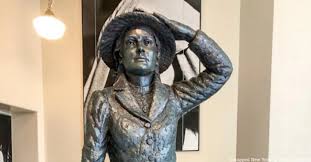In 1891, a seventeen-year-old girl named Annie Moore embarked on a journey that would forever leave an indelible mark on American history. Alongside her two younger brothers, Annie set sail from Ireland, seeking to reunite with their parents in the United States after a lengthy separation. Their story was not unique, as thousands of immigrants had already made this arduous journey in the late 19th century. However, what awaited Annie and her brothers on American soil would make her a figure of historical significance.
On December 31, 1891, the steamship Nevada carrying Annie and her siblings arrived at the shores of the United States. Due to the late arrival, the passengers on board were unable to be processed that day. Little did they know, this twist of fate would grant them an unexpected honor. On January 1, 1892, the Moore siblings became the first immigrants to pass through the newly-built immigration station on Ellis Island, making Annie Moore the first person to be processed there.
Ellis Island: A Symbol of Hope and New Beginnings
Before becoming an immigration station, Ellis Island served as a military outpost in New York Bay. In the late 19th century, the United States government recognized its potential as the ideal location for the first federal immigration station. From its opening in 1892 until its closure in 1954, over 12 million immigrants would walk through the halls of Ellis Island, forever changing the fabric of American society. Today, it remains a symbol of hope and the start of a new life for many.
On January 2, 1892, the ships adorned with red, white, and blue decorations arrived at the port below the iconic Statue of Liberty. The crowd erupted in cheers as the gangplank was lowered, and Annie Moore, a young Irish girl, stepped off the ship and into American history. There is even a story that recounts how Annie narrowly beat out a “large German man” who attempted to board before her, but was held back with a call of “Ladies First!”
Welcoming Annie Moore to Ellis Island
Upon her arrival, Annie Moore was escorted to a registration desk, where she was greeted by Mr. Charles M. Hendley, the former private secretary of Secretary of the Treasury William Windom. Hendley, as a special favor, requested the privilege of registering the first immigrant. With a cheerful tone, he asked Annie, “What is your name, my girl?” and presented her with a $10 gold piece. It was the first American coin she had ever seen and the largest sum of money she had ever possessed. Annie vowed to cherish it as a pleasant memento of this significant occasion.
After completing the registration process, Annie Moore rushed to the waiting room to embrace her eagerly waiting parents. Her journey to America was finally complete, and little did she know that her name would forever be etched in the annals of history.
Annie Moore’s Legacy
While some immigrants went on to settle in various parts of the United States, Annie Moore chose to remain in the Lower East Side of Manhattan. There, she married a clerk and had a family of at least 11 children, although only five survived into adulthood. Sadly, Annie passed away in 1924 due to heart failure and was laid to rest beside her children in Queens.
For many years, it was believed that the Annie Moore of Ellis Island had met a tragic fate in Texas after being struck by a streetcar. However, in 2006, genealogists discovered that the unfortunate Annie Moore from Texas was actually a different person who shared the same name.
Annie Moore’s story serves as a reminder of the courageous individuals who braved the unknown, seeking a better life in America. Her legacy lives on, representing the millions of immigrants who began their American journey at Ellis Island.
To explore more captivating images of Ellis Island immigrants, click here and be transported back in time. Additionally, don’t miss these fascinating 35 Ellis Island photos that capture the early diversity of America.
